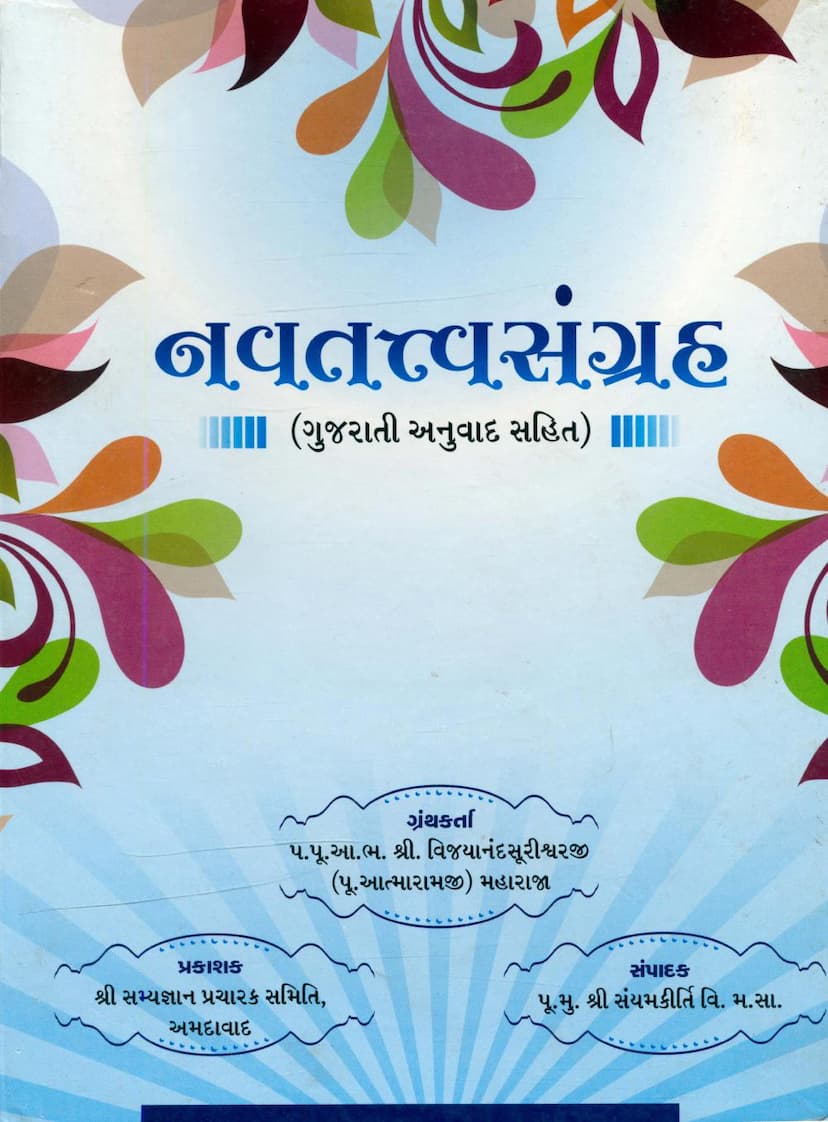Navtattva Sangraha
Added to library: September 2, 2025

Summary
Here's a comprehensive summary of the provided Jain text, "Navatattva Sangraha," focusing on its key elements and content:
Book Title: Navatattva Sangraha (Meaning: Collection of Nine Principles) Author: Acharya Bhagwant Shri Vijayanandsurishwarji (Pujya Shrimad Atmaramji) Maharaja Publisher: Shri Samyagyan Pracharak Samiti, Ahmedabad Editor: Pujya Munivar Shri Sanyamkirtivijayji M.S.
Overall Purpose and Context:
The book "Navatattva Sangraha" is a foundational Jain text authored by the renowned Acharya Vijayanandsurishwarji. It is dedicated to elaborating on the nine fundamental principles (Tattvas) of Jainism, which are crucial for understanding the path to liberation (Moksha). The current edition is a Gujarati translation with the original text, making it accessible to a wider audience. The republication is presented as a tribute to Acharya Vijayanandsurishwarji and to fulfill the vision of his followers to bring his works to the next generation. The text draws heavily from various Jain Agam scriptures like Shri Bhagavati Sutra, Shri Pannavana Sutra, and Shri Jivabhigam Sutra, presenting the nine principles through detailed explanations and numerous tables (Kothas) for clarity.
Key Content and Structure:
The core of the book revolves around the detailed explanation of the Nine Tattvas (Navatattva), which are the bedrock of Jain philosophy and the path to spiritual liberation. These are:
-
Jiva (Soul): This is the most extensively discussed tattva. The book delves into its various classifications, including the number of souls in different realms (Naraka, Tiryanche, Manushya, Deva), the types of bodies (Audarika, Vaikriya, Aharaka, Tejas, Karman), the states of souls based on senses, yoga, congregation, knowledge, karma, etc. It includes intricate details about the permutations and combinations of these classifications, often presented in tabular form, referencing ancient Jain Agamas. The text also touches upon the lifecycle of souls, their origins, and their journey through different states of existence. The biographical sketch of Acharya Vijayanandsurishwarji himself is included, detailing his life, conversion to Jainism, and his significant role in strengthening Jain religious practices, particularly monastic ordinations.
-
Ajiva (Non-soul): This section likely covers the remaining fundamental principles that are not jiva, such as:
- Pudgala (Matter): Discussed extensively with details on atomicity, forms, combinations, and states of matter, referencing scriptures like Shri Pannaavna Sutra.
- Dharma (Medium of Motion): Explained as an essential principle for the soul's movement.
- Adharma (Medium of Rest): Described as the principle that aids in the soul's stationary existence.
- Akaasha (Space): Encompassing both the realm of souls and matter (lokakaasha) and the infinite space beyond (alokakaasha).
- Kaala (Time): Discussed in terms of its eternity and its role in the manifestation of phenomena.
- Bandha (Bondage): The process by which karmas attach to the soul, with detailed explanations of various types of bondages and their causes, often presented in extensive tables of karmic permutations and combinations.
- Punya (Merit): The results of virtuous actions that lead to happiness and favorable circumstances.
- Paap (Demerit): The results of sinful actions that lead to suffering and unfavorable circumstances.
- Samvara (Suppression of Karma): The process of stopping the influx of new karmas through virtuous conduct, vows, and austerities. The book details the various ways to achieve Samvara, including the five Samitis (careful conduct) and three Guptis (restraint).
- Nirjara (Cessation of Karma): The process of shedding existing karmas through austerities and spiritual practices. This section likely details various types of austerities and their benefits in the path of liberation.
- Moksha (Liberation): The ultimate goal of Jainism, the state of complete freedom from karma and the cycle of birth and death, achieved through the eradication of all passions and the attainment of omniscience.
Key Features of the Book:
- Comprehensive Detail: The text aims to provide an exhaustive explanation of each of the nine tattvas, drawing from multiple scriptural sources.
- Tabular Presentation: A significant feature is the extensive use of tables (Kothas or Yantras) to illustrate complex classifications and numerical data related to souls, karmas, space, time, and other principles. These tables are vital for understanding the intricate details of Jain cosmology and philosophy.
- Rooted in Agamas: The author's deep scholarship and reliance on authoritative Jain scriptures are evident throughout the work, ensuring the accuracy and authenticity of the teachings.
- Gujarati Translation: The inclusion of a Gujarati translation alongside the original text makes the profound philosophical concepts of Jainism accessible to Gujarati-speaking readers.
- Biographical Element: The inclusion of the life and contributions of Acharya Vijayanandsurishwarji provides context and reverence to the work, highlighting his impact on the Jain community and his commitment to promoting spiritual knowledge.
- Focus on Practice: While philosophical, the book ultimately guides the reader towards practical application for spiritual progress and the ultimate goal of liberation.
Significance and Purpose:
The "Navatattva Sangraha" serves as a vital resource for Jain scholars, monks, nuns, and lay followers seeking a deep understanding of the core principles of their faith. By systematically detailing the nine tattvas, the book equips individuals with the knowledge necessary to cultivate right faith (Samyak Darshan), right knowledge (Samyak Gyan), and right conduct (Samyak Charitra), which are the three jewels of Jainism and the path to Moksha. The meticulous compilation of information, often presented in a highly structured and numerical format through tables, underscores the Jain emphasis on precise knowledge and logical reasoning in spiritual matters. The book aims to strengthen the faith of the readers and guide them towards spiritual upliftment and the ultimate attainment of liberation.